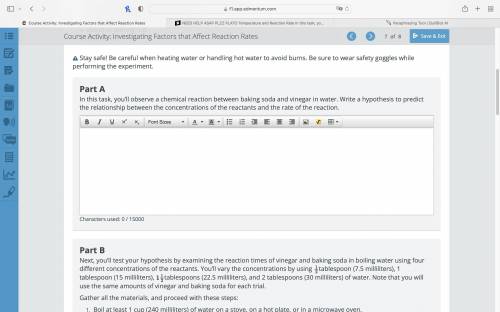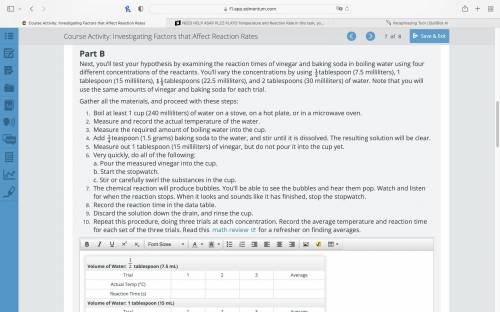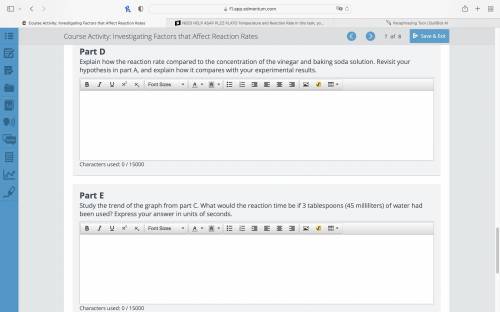NEED HELP ASAP
Concentration and Reaction Rate
In this task, you will determine how the conc...

NEED HELP ASAP
Concentration and Reaction Rate
In this task, you will determine how the concentrations of the reactants affect the reaction rate, or how quickly a reaction takes place. Before you begin this task, read these lab safety guidelines. If you need a refresher on using a graduated cylinder and an electronic balance, watch the videos about measuring volume and measuring mass.
Estimated time to complete: 90 minutes
If you’re using an Edmentum lab kit, remove the electronic balance, graduated cylinder, thermometer, and safety goggles. These materials are italicized in the following equipment list. Then gather the additional items shown in the list. If you’re not using an Edmentum lab kit, alternatives are suggested in parentheses. If you do not have access to these materials, please check with your teacher for help.
You’ll need these materials:
graduated cylinder (may also use a 1-tablespoon measure)
electronic balance, precise to at least 0.1 gram, with weighing boat (may also use a
1
4
-teaspoon measure)
thermometer, readable from 0°C to 100°C (32°F to 212°F)
safety goggles
3
4
cup (180 milliliters) vinegar
1 tablespoon (18 grams) baking soda
water
stove, hot plate, or microwave oven (for heating water)
container appropriate for heating water
beaker, flask, or cup
spoon or stirring rod
stopwatch
Stay safe! Be careful when heating water or handling hot water to avoid burns. Be sure to wear safety goggles while performing the experiment.
Part A
In this task, you’ll observe a chemical reaction between baking soda and vinegar in water. Write a hypothesis to predict the relationship between the concentrations of the reactants and the rate of the reaction.
Part B
Next, you’ll test your hypothesis by examining the reaction times of vinegar and baking soda in boiling water using four different concentrations of the reactants. You’ll vary the concentrations by using
1
2
tablespoon (7.5 milliliters), 1 tablespoon (15 milliliters),
1
1
2
tablespoons (22.5 milliliters), and 2 tablespoons (30 milliliters) of water. Note that you will use the same amounts of vinegar and baking soda for each trial.
Gather all the materials, and proceed with these steps:
Boil at least 1 cup (240 milliliters) of water on a stove, on a hot plate, or in a microwave oven.
Measure and record the actual temperature of the water.
Measure the required amount of boiling water into the cup.
Add
1
4
teaspoon (1.5 grams) baking soda to the water, and stir until it is dissolved. The resulting solution will be clear.
Measure out 1 tablespoon (15 milliliters) of vinegar, but do not pour it into the cup yet.
Very quickly, do all of the following:
a. Pour the measured vinegar into the cup.
b. Start the stopwatch.
c. Stir or carefully swirl the substances in the cup.
The chemical reaction will produce bubbles. You’ll be able to see the bubbles and hear them pop. Watch and listen for when the reaction stops. When it looks and sounds like it has finished, stop the stopwatch.
Record the reaction time in the data table.
Discard the solution down the drain, and rinse the cup.
Repeat this procedure, doing three trials at each concentration. Record the average temperature and reaction time for each set of the three trials. Read this math review for a refresher on finding averages.
Part C
Question
Draw a graph of the average reaction time (variable y) versus the amount of water added (variable x) using your data from part B.
Part D
Explain how the reaction rate compared to the concentration of the vinegar and baking soda solution. Revisit your hypothesis in part A, and explain how it compares with your experimental results.
Part E
Study the trend of the graph from part C. What would the reaction time be if 3 tablespoons (45 milliliters) of water had been used? Express your answer in units of seconds.
Part F
Why is it a good idea to perform three trials at each concentration? How would you modify the experiment to produce more reliable results?






Answers: 2
Another question on Chemistry

Chemistry, 21.06.2019 21:30
Which is the layer underground where all empty spaces are filled with a combination of air and water ?
Answers: 1


Chemistry, 22.06.2019 17:00
The msds for glacial acetic acid says that it is a flammable liquid that can severely burn any human tissue it comes in contact with. it reacts with bases, various metals, and strong oxidizing agents. its vapors can form explosive mixtures with air.
Answers: 1

Chemistry, 22.06.2019 20:00
Listenbase your answer to the question on the information below.nuclear radiation is harmful to living cells, particularly to fast-growing cells, such as cancer cells and blood cells. an external beam of the radiation emitted from a radioisotope can be directed on a small area of a person to destroy cancer cells within the body.cobalt-60 is an artificially produced radioisotope that emits gamma rays and beta particles. one hospital keeps a 100.0-gram sample of cobalt-60 in an appropriate, secure storage container for future cancer treatment.which choice represents the correct product for the beta decay of the co-60? fe-60ni-60fe-61ni-61
Answers: 2
You know the right answer?
Questions


Social Studies, 09.10.2019 21:30


Biology, 09.10.2019 21:30



History, 09.10.2019 21:30

Spanish, 09.10.2019 21:30


Mathematics, 09.10.2019 21:30

Biology, 09.10.2019 21:30

Chemistry, 09.10.2019 21:30

Mathematics, 09.10.2019 21:30



Mathematics, 09.10.2019 21:30






